Table of Contents
- Introduction
- Why Digital Transformation in Schools Matters for Tier II & III Cities
- Current Landscape: EdTech Growth and the Opportunity
- Challenges Slowing Digital Transformation in Schools
- High-impact Solutions to Accelerate Digital Transformation in Schools
- Step-by-step Roadmap: How Schools Can Start Digital Transformation in Schools Today
- Tech Choices: What to Buy and What to Avoid
- Measuring Success: KPIs for Digital Transformation in Schools
- Cost, ROI and Funding Options for Digital Transformation in Schools
- Case Studies & Evidence: What Works in Smaller Cities
- Quick Implementation Checklist (30-day plan)
- FAQs
- What is digital transformation in schools and why is it urgent for Tier II & Tier III cities?
- How much does digital transformation in schools cost for a small school?
- Will teachers in Tier II & Tier III cities adopt new digital tools?
- Can digital transformation in schools work with low internet or shared devices?
- What outcomes should schools expect after 12 months?
- Conclusion
Introduction
India’s smaller cities are changing fast. Students in Tier II and Tier III towns expect the same access to quality learning as those in metros. Yet many schools lag behind. This gap creates real pain: lower learning outcomes, teacher burnout, and shrinking enrollments. The solution is clear — digital transformation in schools. By adopting smart classrooms, learning management systems (LMS), and blended learning, schools can bridge quality gaps, improve outcomes, and remain competitive.
In this post, we explain why digital transformation in schools matters for Tier II & Tier III cities. We give a practical roadmap, budget estimates, KPIs, and easy-to-implement examples. Read on if you want your school or coaching institute to stay relevant, measurable, and future-ready.
Why Digital Transformation in Schools Matters for Tier II & III Cities
Digital transformation in schools is not just a buzzword. It is a structural change with measurable benefits. First, it expands access. A well-deployed LMS and recorded lessons let rural students catch up on missed classes. Second, it improves teaching quality by enabling data-driven instruction and adaptive learning. Third, it reduces costs in the long run by centralizing resources and automating administrative tasks.
Benefits at a glance:
- Faster remediation through adaptive learning and analytics.
- Higher student engagement via interactive content and multimedia.
- Better teacher support with digital lesson plans and assessment tools.
- Scalable exam-prep and enrichment programs that reach beyond city limits.
These outcomes are exactly what schools in Tier II & Tier III cities need to close the performance gap with urban peers.
Current Landscape: EdTech Growth and the Opportunity
EdTech adoption in smaller Indian cities has accelerated. Smartphone penetration and cheaper internet are major drivers. As a result, many coaching institutes and private schools have seen strong demand for online resources. This creates a window of opportunity for K-12 schools to modernize.
Key trends to watch:
- Rapid growth of smart classroom adoption and hybrid learning models.
- Expansion of low-cost devices and local-language content.
- Growing parental willingness to pay for measurable learning gains.
For school leaders, timing matters. Early adopters in Tier II & Tier III cities gain a lasting advantage: improved reputation, better student retention, and new revenue lines like weekend online coaching and test-prep modules.
Challenges Slowing Digital Transformation in Schools
Many barriers slow adoption. Recognizing them helps design realistic plans.
Infrastructure and connectivity
Reliable internet and electricity remain inconsistent in some towns. Without basic infrastructure, even the best platform fails.
Teacher readiness and training for digital transformation in schools
Teachers often lack training in digital pedagogy. Rolling out devices without sustained teacher development creates underused technology and frustration.
Affordability and device access
Families in smaller towns may not afford devices for every child. Schools must plan device-sharing models or school-provided labs.
Change management and leadership
Digital transformation in schools is a people problem first. Without leadership buy-in and clear incentives, projects stall.
High-impact Solutions to Accelerate Digital Transformation in Schools
A practical approach focuses on low-friction, high-impact interventions. Start small, measure often, and scale fast.
1. Basic digital foundation
- Ensure stable internet in administrative and teaching blocks.
- Equip at least one digital lab or smart classroom per school.
- Use an energy-efficient projector or a large LED screen and a low-cost interactive pen or tablet.
2. Learning Management System (LMS) + School ERP
An LMS centralizes lessons, assignments, and analytics. School ERP automates fees, attendance, and communications. Together they reduce admin time and free teachers to focus on pedagogy.
3. Blended learning and flipped classrooms
Flip the classroom: students watch short videos at home and use class time for practice. This model is bandwidth-friendly and raises in-class engagement.
4. Adaptive and personalized learning
Use adaptive platforms to identify learning gaps and deliver targeted remediation. This method can accelerate learning gains, especially for early grades.
5. Teacher training and continuous PD
Invest in regular, practical training sessions. Pair digital tool rollouts with micro-credentialing for teachers to sustain adoption.
Step-by-step Roadmap: How Schools Can Start Digital Transformation in Schools Today
Below is a phased roadmap that schools in Tier II & Tier III cities can follow.
Phase 0 — Leadership and vision (0–1 month)
- Appoint a digital champion (VP/Head Teacher).
- Define clear objectives (attendance, test scores, enrollment targets).
- Set a 12-month pilot plan for one or two grades.
Phase 1 — Foundation (1–3 months)
- Secure basic internet and a smart classroom setup.
- Deploy an LMS trial and a simple School ERP.
- Train a pilot group of teachers with hands-on workshops.
Phase 2 — Pilot and measure (3–9 months)
- Run the pilot for one academic term.
- Track KPIs: student logins, assignment completion, learning gains.
- Collect teacher and parent feedback.
Phase 3 — Scale and optimize (9–24 months)
- Scale to all grades based on pilot results.
- Introduce adaptive learning for core subjects.
- Optimize scheduling and devices to maximize usage.
Phase 4 — Sustain and expand (24+ months)
- Build a local content library in regional languages.
- Monetize extra capacity through weekend online classes.
- Partner with local governments or CSR for funding.
Quick Budget Snapshot (Example for a 300-student school)
| Item | Estimate (INR) | Notes |
|---|---|---|
| Smart classroom (projector, speakers, interactive pen) | 80,000 | One setup per 3–5 classrooms shared |
| Basic LMS subscription (annual) | 60,000 | Scales with users and modules |
| School ERP (annual) | 40,000 | Automates admin functions |
| Teacher training & PD (annual) | 50,000 | Ongoing micro-credentialing |
| Connectivity (annual) | 24,000 | Back-up 4G link + primary broadband |
| Total first-year (approx.) | 254,000 | Cost per student ≈ ₹847/year |
This example shows that a practical digital transformation in schools is affordable on a per-student basis and usually recovers through increased enrollments and fee efficiencies.
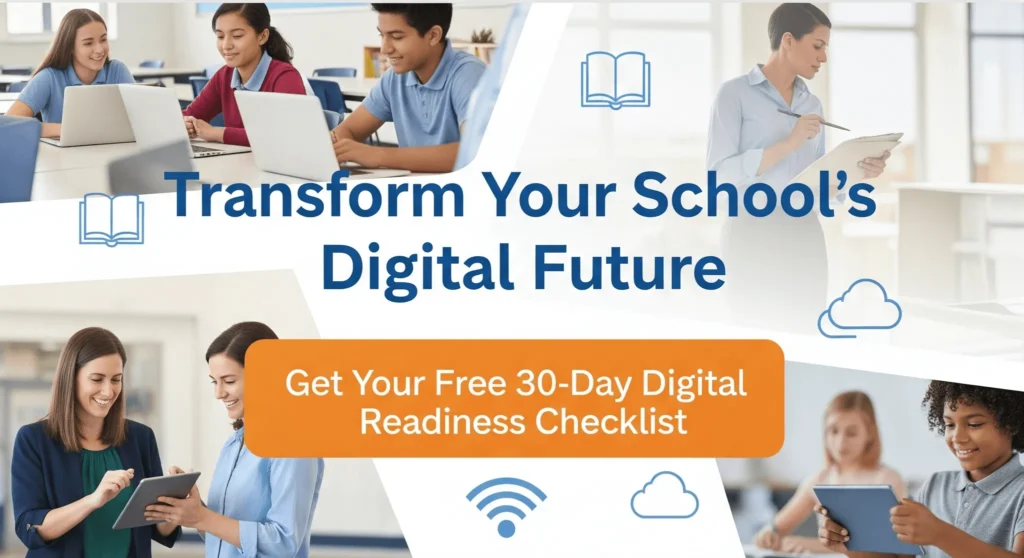
Tech Choices: What to Buy and What to Avoid
Choose solutions built for low-bandwidth, multilingual classrooms. Avoid bulky, expensive interactive whiteboards if your teachers are not trained to use them.
Purchase checklist:
- LMS with offline mode and regional language support.
- Lightweight school ERP with mobile parent app.
- Modular adaptive learning tools for Math and Language.
- Local content partners for regional curriculum alignment.
Measuring Success: KPIs for Digital Transformation in Schools
Track these indicators to evaluate impact:
- Student engagement: daily active users and video watch time.
- Academic outcomes: improvement in formative and summative scores.
- Teacher adoption: lesson uploads and digital assignment rates.
- Attendance and retention: monthly percentage change.
- Operational savings: reduction in manual admin hours.
Set realistic targets. For example, aim for 60–70% teacher adoption in the first year and 15–25% improvement in formative assessment scores in two years.
Cost, ROI and Funding Options for Digital Transformation in Schools
Digital transformation in schools often shows ROI in 18–36 months. Sources of funding include:
- Parent-funded device programs (EMI options).
- Local CSR partnerships and state / central schemes.
- Education loans designed for school infrastructure.
- Phased subscription models that scale as adoption grows.
Build ROI models that include increased enrollment, fee retention, and reduced admin costs. Also factor in qualitative benefits such as improved reputation and parent satisfaction.
Case Studies & Evidence: What Works in Smaller Cities
Real-world examples show that targeted digital interventions work.
Example: Personalized adaptive learning programs in state initiatives delivered accelerated learning gains. When digital tools are combined with governance and teacher coaching, results scale rapidly.
Example: Coaching institutes in smaller cities have monetized recorded lessons and hybrid classes. Schools can replicate this by offering after-school digital clubs, thereby adding revenue and increasing student outcomes.
These case studies reinforce a simple fact: digital transformation in schools must be purposeful, supported by training, and measured rigorously.
Quick Implementation Checklist (30-day plan)
- Appoint a project lead.
- Select one LMS and ERP vendor for a pilot.
- Set up one smart classroom or digital lab.
- Train 5–8 teachers on basic tools.
- Run a parent orientation session explaining benefits and safety.
- Collect baseline student performance data.
FAQs
What is digital transformation in schools and why is it urgent for Tier II & Tier III cities?
Digital transformation in schools means integrating digital tools, platforms, and processes into teaching, learning, and administration. It is urgent in smaller cities because it levels the playing field, improves outcomes, and addresses teacher shortages and resource gaps.
How much does digital transformation in schools cost for a small school?
Costs vary. A basic first-year setup for a 300-student school can be under ₹3 lakh (see budget snapshot). Per-student annual costs often drop under ₹1,000 as scale improves.
Will teachers in Tier II & Tier III cities adopt new digital tools?
Yes—if training is practical and sustained. Teacher adoption rises when tools reduce daily workload and show clear learning gains.
What outcomes should schools expect after 12 months?
After a structured 12-month pilot, expect meaningful teacher adoption, improved engagement metrics, and early signs of score improvement in formative assessments.
Conclusion
Digital transformation in schools is no longer optional for Tier II & Tier III cities. It is the fastest way to improve learning outcomes, increase operational efficiency, and stay competitive. Schools that act now will see measurable gains in engagement and performance. Start with a focused pilot, invest in teacher training, measure the right KPIs, and scale what works.
If you run a school, coaching institute, or education chain in a Tier II or Tier III city, take the next step today. Contact Legacy EdTech to design a tailored digital transformation in schools roadmap, pilot an LMS, and train your teachers for long-term impact.



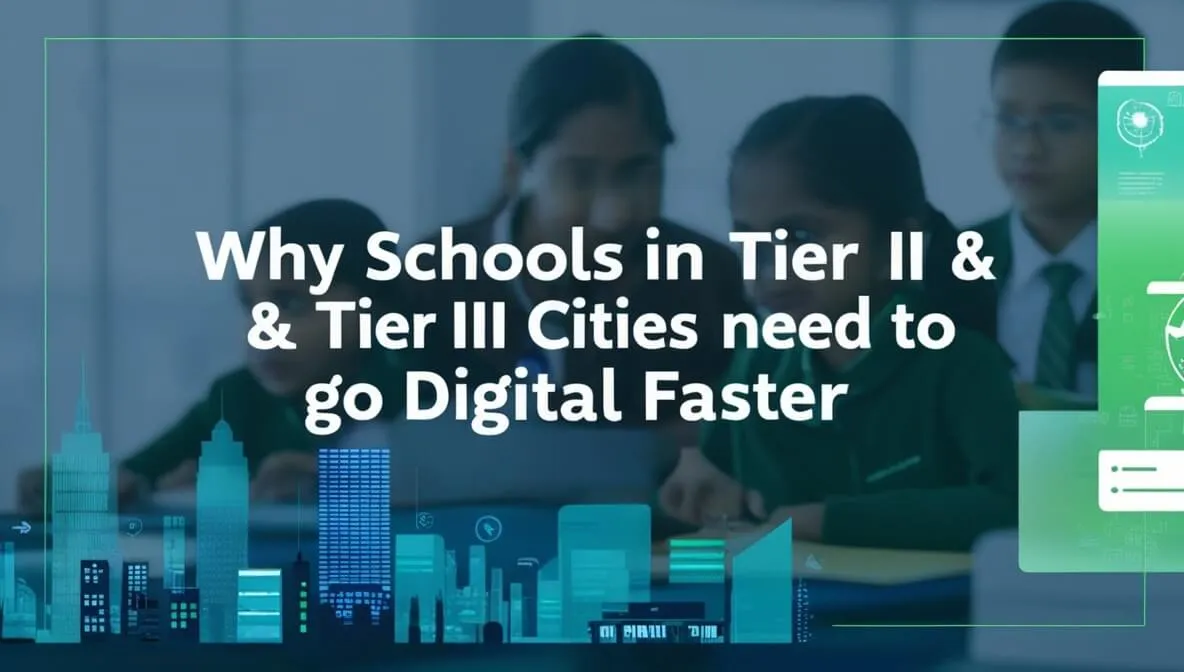
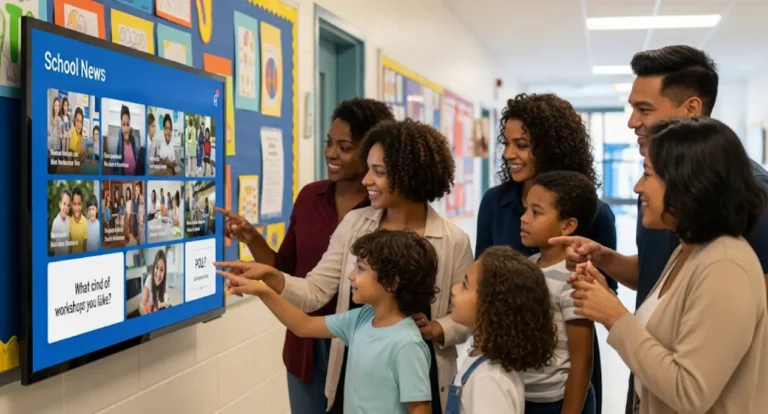
Thanks for putting in the effort to write this.